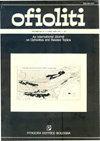海洋岩石圈富橄榄石橄榄岩的成因:高寒侏罗系蛇绿岩与现代慢扩张脊的比较
IF 1.3
4区 地球科学
Q2 GEOLOGY
引用次数: 15
摘要
富橄榄石滑石体产于沿阿尔卑斯-亚平宁带暴露的侏罗纪海洋岩石圈下壳幔段。这些岩石的结构和成分与来自缓慢扩张脊的富含橄榄石的橄榄岩相似。阿尔卑斯-亚平宁带富橄榄石的橄榄石中含有圆形至椭圆形的橄榄石(Fo = 89 ~ 87 mol%)和高Mg#(90 ~ 88)的斜辉石型橄榄石。在典型morb型平衡熔体中,斜辉石的Cr2O3 (1.6 ~ 1.3 wt%)高于斜辉石,Ti/Yb低于斜辉石。这些化学特征很可能是由富橄榄石基质与斜辉石和斜长石结晶的迁移熔体之间的反应获得的。阿尔卑斯-亚平宁带富橄榄石橄榄岩斜长石的钙长石成分(71 ~ 61 mol%)普遍低于缓展脊富橄榄石橄榄岩斜长石。阿尔卑斯-亚平宁带富橄榄岩的迁移熔体,相对于通常产自缓慢扩张脊的玄武岩,其Na2O含量可能略高。我们将这种Na2O富集归因于软流圈源的低熔融程度。来自化石和现代海洋岩石圈的富橄榄石橄榄岩可能形成于幔壳过渡时期。辉长岩层序中富橄榄石橄榄岩体的赋存与下地壳发育过程中幔壳过渡的剥离和圈闭过程相协调。本文章由计算机程序翻译,如有差异,请以英文原文为准。
ORIGIN OF OLIVINE-RICH TROCTOLITES FROM THE OCEANIC LITHOSPHERE: A COMPARISON BETWEEN THE ALPINE JURASSIC OPHIOLITES AND MODERN SLOW SPREADING RIDGES
Olivine-rich troctolite bodies occur within lower crust and mantle sections of the Jurassic oceanic lithosphere exposed along the Alpine-Apennine belt. These rocks bear structural and compositional resemblances to the olivine-rich troctolites from slow spreading ridges. The olivine-rich troctolites from the Alpine-Apennine belt contain olivines (Fo = 89-87 mol%) with rounded to embayed morphology and clinopyroxene oikocrysts with high Mg# (90-88). The clinopyroxene oikocrysts have higher Cr2O3 (1.6-1.3 wt%) and lower Ti/Yb than clinopyroxenes in equilibrium typical MORB-type melts. These chemical characteristics were most likely acquired by reaction between an olivine-rich matrix and migrating melts crystallizing clinopyroxene and plagioclase. The pla- gioclases from the olivine-rich troctolites of the Alpine-Apennine belt are commonly poorer in anorthite component (71-61 mol%) than the plagioclases from slow spreading ridge olivine-rich troctolites. The migrating melts involved in the formation of the olivine-rich troctolites from the Alpine-Apennine belt were most likely slightly enriched in Na2O with respect to the basalts normally produced at slow spreading ridges. We attribute this Na2O enrichment to a low de- gree of melting of asthenospheric sources. The olivine-rich troctolites from fossil and modern oceanic lithosphere probably formed at the mantle-crust transi- tion. The occurrence of olivine-rich troctolite bodies within gabbroic sequences is reconciled with a process of dissection and entrapment of the mantle-crust transition during the growth of the lower crust.
求助全文
通过发布文献求助,成功后即可免费获取论文全文。
去求助
来源期刊

Ofioliti
地学-地质学
CiteScore
2.40
自引率
7.70%
发文量
1
期刊介绍:
Since 1976, Ofioliti provides an international forum for original contributions and reviews in the field of the geodynamics, petrology, geochemistry, biostratigraphy, stratigraphy, tectonics and paleogeography applied to ophiolitic terrains and modern oceanic lithosphere, including their sedimentary cover. Studies of topics such as geodynamics of the mantle, the evolution of orogens including ophiolites and paleoceanography are also welcome
 求助内容:
求助内容: 应助结果提醒方式:
应助结果提醒方式:


